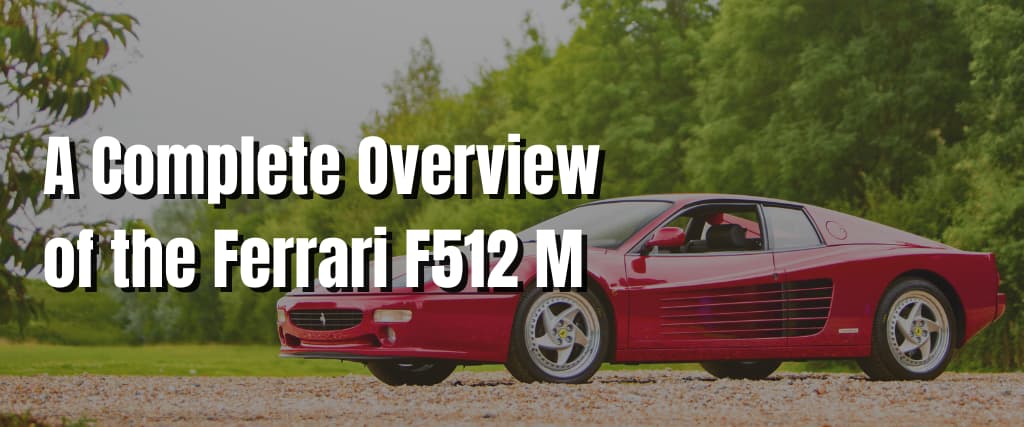When it comes to high-performance cars, few names evoke as much awe and admiration as Ferrari. For many years, this brand has represented automotive excellence, constantly pushing the boundaries of speed, style, and precision engineering. One of the most iconic vehicles that have emerged from Ferrari’s factory in Maranello is the Ferrari F512 M – a leading example of timeless supercar prowess.
The F512 M was born from the prestigious Testarossa lineage and made its grand entrance onto the world stage in the mid-1990s. It left an indelible mark on the history of the automotive industry as a machine that embodies the true essence of a supercar: a stunning design, a soul-stirring V12 engine, and a driving experience that is nothing short of intoxicating.
This article takes you on a captivating journey into the heart of the Ferrari F512 M, exploring its history, design, performance, and the sheer exhilaration of being behind the wheel. We celebrate a supercar icon that continues to inspire and captivate, even decades after its creation. You’ll soon discover the Ferrari F512 M isn’t just another car; it’s a work of art and a testament to the relentless pursuit of automotive perfection.
History
The Ferrari F512 M, also known as the Ferrari Testarossa M, is the evolution of the iconic Ferrari Testarossa. It made its debut in 1994 at the Paris Motor Show and was produced until 1996 – marking the end of the Testarossa lineage.
The ‘M’ in its name stands for ‘Modificata’, which reflects the various enhancements and improvements made to the original Testarossa.
Design and Styling

One of the first things that grab your attention when you look at the Ferrari F512 M is its unmistakable design. This car’s styling was influenced by the 1984 Testarossa, but it brought several significant improvements and modern touches that made it stand out even more.
The F512 M featured a low, wide and aerodynamic body, which was a hallmark of Ferrari design at the time. The iconic side strakes – or ‘cheese graters’ – remained a prominent feature, allowing for better engine cooling while making a bold visual statement. The pop-up headlights, a staple of the era, were retained – giving the F512 M its unique look.
The exterior design was not just about aesthetics, though. The Ferrari F512 M’s design contributed to its impressive aerodynamics, with the car having a drag coefficient of just 0.36, a notable achievement for the mid-’90s. The side-mounted radiators allowed for improved airflow and the wider rear track enhanced stability at high speeds.
Inside, the F512 M offered a driver-focused cockpit. The interior featured sumptuous leather upholstery, a polished wooden dashboard and a more driver-oriented layout compared to the original Testarossa. While it might lack some modern comforts and technology that we see in today’s supercars, the F512 M’s cabin exuded a sense of luxury and purpose.
Performance and Engine
The heart of any Ferrari is its engine, and the F512 M certainly did not disappoint. Under the rear bonnet, you’d find a 4.9-litre flat-12 engine that produced an exhilarating 440 horsepower and 370 lb-ft of torque. This engine was mated to a traditional gated 5-speed manual transmission, a choice that delighted purists and added to the overall driving experience.
The F512 M was rear-wheel drive, and it sprinted from 0 to 60 mph in just 4.7 seconds. While that might not seem exceptionally quick by today’s standards, it was an impressive feat in the ’90s. The top speed was rated at 195 mph, making it one of the fastest cars of its time. The melodious soundtrack of the 12-cylinder engine, which went all the way to its 7,250 rpm redline, was music to the ears of car enthusiasts.
The engine’s performance was further enhanced by its placement, which allowed for better weight distribution, contributing to the F512 M’s excellent handling characteristics. The suspension was firm yet compliant, and the steering offered great feedback, allowing the driver to have a more connected and engaging experience behind the wheel.
Driving Experience

The Ferrari F512 M was a car designed to be driven. It offered a raw, unfiltered driving experience that connected the driver to the road.
The manual transmission, with its traditional gate shifter, made gear changes a satisfying and involving task. While modern supercars have moved towards automatic transmissions and paddle shifters for their speed and convenience, the F512 M stayed true to the art of driving.
The car’s handling was balanced and responsive. Overall, the chassis was well-tuned, and the suspension offered a comfortable ride without sacrificing its sporty edge. Cornering was a delight, with the F512 M gripping the road with precision and confidence. The unassisted steering was heavy at low speeds but lightened up as you gained velocity, providing a rewarding and connected experience.
One thing to keep in mind, though, is that the F512 M’s driving experience required skill and attention. It lacked modern electronic driving aids, so it demanded respect for its power and handling capabilities. This added to the thrill of driving, but it also required a certain level of competence behind the wheel.
Ownership and Maintenance
Many people dream of owning a Ferrari F512 M, but it’s important to understand the responsibilities that come with it. As a vintage supercar, the F512 M requires high maintenance and repair costs. Here are some crucial points to consider if you’re thinking about becoming an owner:
Regular servicing and maintenance are vital to keep the F512 M in top shape. This includes oil changes, brake inspections, and general upkeep. Be prepared for high costs because Ferrari servicing is specialised.
One of the most critical maintenance tasks is replacing the timing belt. The flat-12 engine in the F512
M has a timing belt that should be replaced every 30,000 miles or every three years. Neglecting this can lead to catastrophic engine failure.
Finding a reputable mechanic who has experience working on Ferraris is essential. The knowledge and expertise required to maintain and repair these cars are specific, and not all automotive shops have it.
Some parts for the F512 M can be challenging to source, and they can be expensive. This is particularly true for unique or Ferrari-specific components.
While the F512 M can be driven on the road, it’s not the most practical daily driver. Limited cargo space, heavy steering at low speeds, and low ground clearance make it more suitable for occasional, spirited drives.
The F512 M, like many classic Ferraris, has the potential to appreciate in value if well-maintained. This can be a silver lining for owners who are mindful of the car’s upkeep.
Collectibility and Resale Value

The Ferrari F512 M has become a sought-after collector’s item over the years. Limited production numbers and its place in Ferrari’s history have contributed to its appreciation in value. Subsequently, for owners who have taken excellent care of their F512 M, it can represent an investment that appreciates in value over time.
It’s worth noting that the Ferrari market can be quite speculative, and the value of these cars can fluctuate. Factors such as condition, maintenance history, and provenance play a significant role in determining the resale value.
Currently, a well-maintained Ferrari F512 M in good condition could fetch six-figure prices in the market. However, these values can rapidly change. So, consult current market trends and experts if you’re considering buying or selling an F512 M.
Conclusion
The Ferrari F512 M is a testament to Ferrari’s commitment to creating exceptional supercars.
From its timeless design to its legendary V12 engine and engaging driving experience, the F512 M holds a special place in the hearts of automotive enthusiasts. Whether you’re a collector looking for a valuable addition to your portfolio or a driving enthusiast seeking an exhilarating experience, the F512 M has much to offer.
While it’s true that owning and maintaining a vintage Ferrari like the F512 M comes with its challenges and costs, the rewards can be immeasurable. The satisfaction of hearing the flat-12 engine roar to life, the feel of the manual shifter in your hand, and the attention-grabbing design are all part of the package. This car is not just a means of transportation; it’s an experience.
Overall, in the world of classic cars, few names evoke as much passion and emotion as Ferrari. The F512 M is no exception, representing an era of supercars that defined automotive enthusiasts’ dreams. Ultimately, it’s a rare gem that captures the essence of automotive art and performance.


